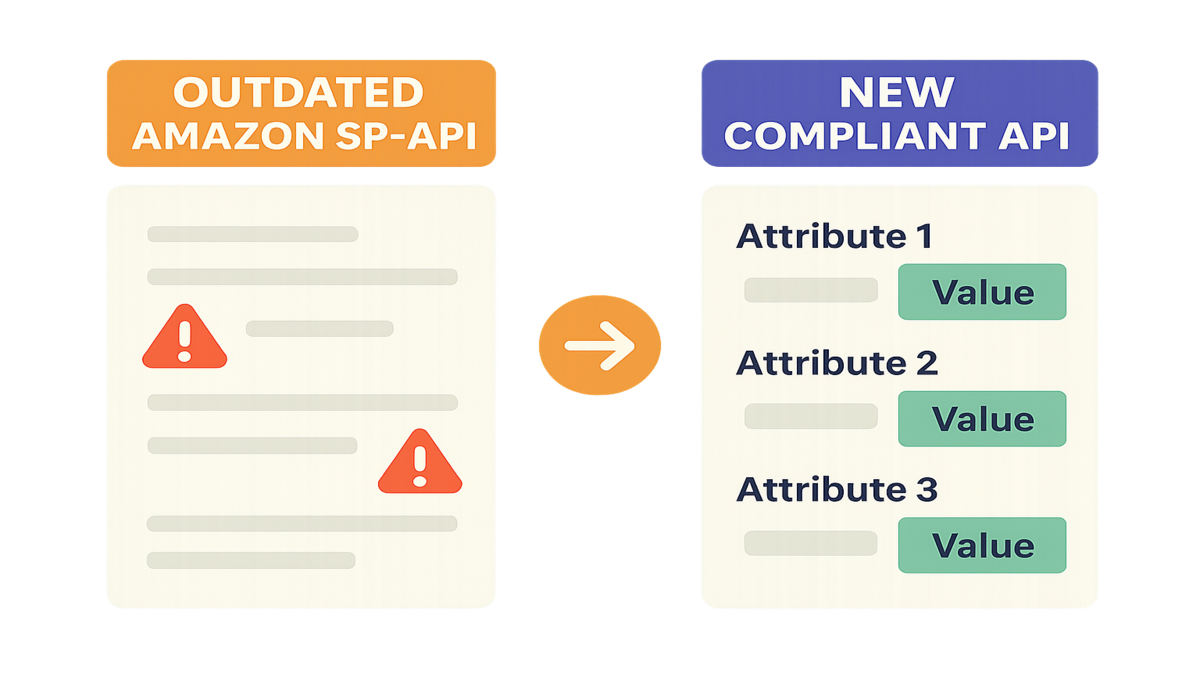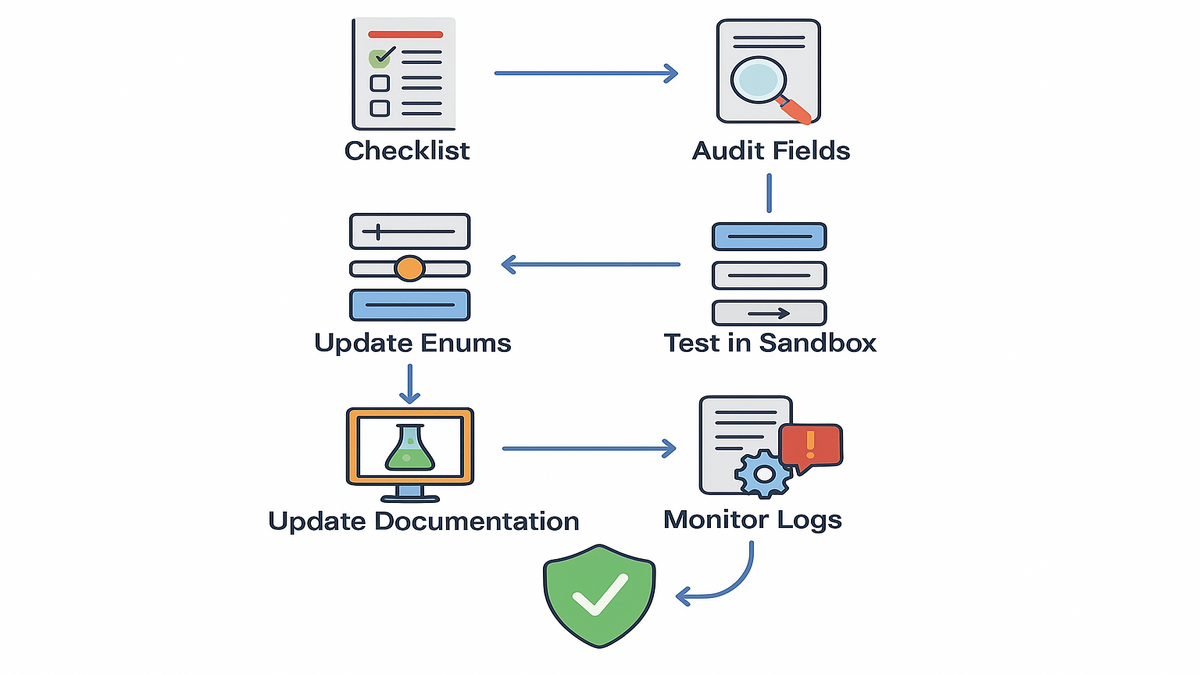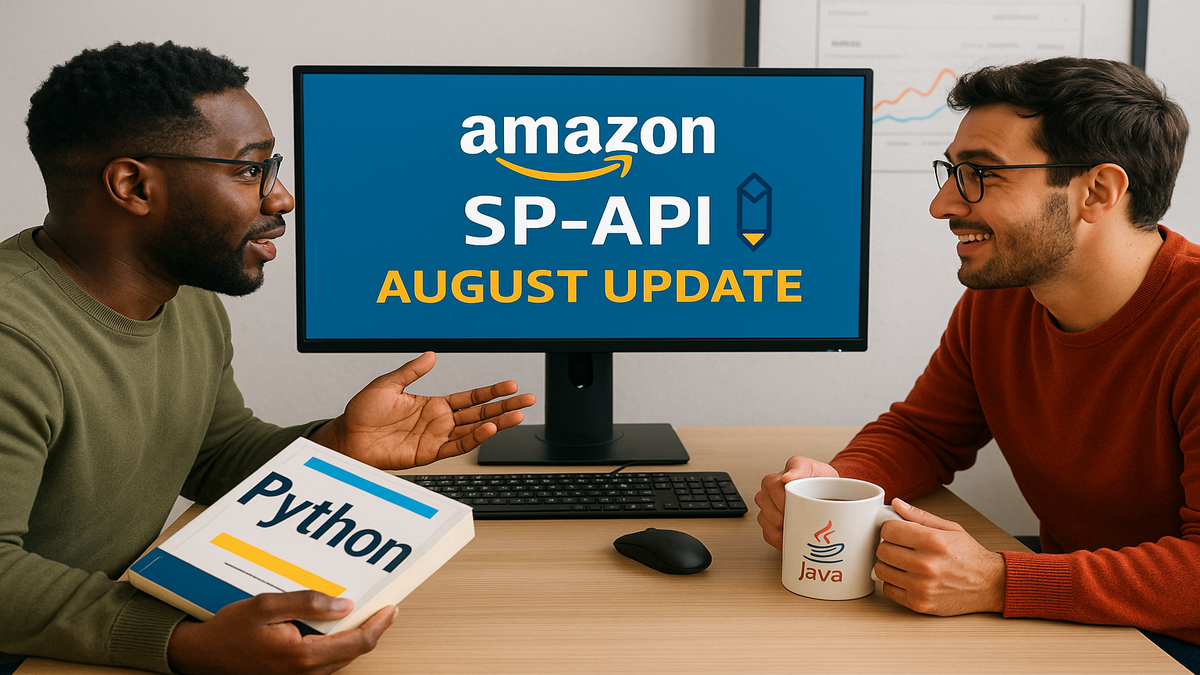
Master the August Amazon SP-API Update in Python & Java

Amazon just dropped a bombshell for every seller and dev out there. With the August 2024 SP-API update, attribute usage and dropdown values (they call them enumerations) are getting a huge overhaul.
Picture this: You need to update hundreds, maybe thousands, of listings and—boom—your API suddenly stops working. This is the new normal.
If you use Python or Java to handle your Amazon listings, this update is not just "FYI." It’s the line between smooth sales and hitting a brick wall. The bright side? If you play by the rules, you’ll get access to new features and your data gets a lot cleaner. Ignore it, though, and your automation could break—or get you flagged by Amazon’s bots.
So, buckle up. I’ll break down why this all matters, what’s changing, share some code-related tips, and give you a no-nonsense checklist to keep your listings safe, even as Amazon keeps raising the stakes.
TL;DR
- Big SP-API update lands August 25, 2024—lots of listing attributes change.
- Dropdown values (enums) are tweaked for data consistency and new rules.
- It’s global—selling on any Amazon site? You’re hit.
- Sellers and devs need to update Python/Java integrations or face listing errors.
- Switching to the Solution Provider Portal soon won’t be optional.
- Ignoring this is not a choice: update or risk broken listings and lost sales.

Why Amazon’s Attribute & Enumeration Changes Matter Now
Compliance Isn’t Optional
Amazon isn’t just tidying up the SP-API. They’re remaking how your product info should look and behave on every marketplace. This is not some minor fix. Think full-on compliance sweep, touching basically everyone who sells or builds anything on Amazon. If you don’t play along, you could see your listings get rejected, sales slow down, maybe even get suspended. Basically, imagine Amazon putting a lock on your shop until you fix your stuff.
“If your integration is held together by old, shaky mapping, you’re toast,” says Jane Li, Amazon Solutions Architect at eComFlow. “Anyone using Python, Java, or their own setup has to update their API payloads—or get ready for a tidal wave of error codes.” Translation: old code is pretty much dead now.
Data Quality
But wait, it’s not just about making your life harder. Amazon wants sellers to send in cleaner, better-structured info. Why? Messy or missing data just makes things confusing for shoppers and their site. If you get this right, you’ll see less errors, faster SKU onboarding, and way fewer “where did that new color go?” headaches.
Nail this update and you’ll spend less time fixing broken listings, more time actually, you know, selling stuff.
Breaking Down the Changes
What’s Different?
- Attribute Usage: Amazon changed which attributes you need to fill in and how. So, a field you used to skip may now be required or checked with new rules. For example, the “shade” field for makeup used to be optional. Now? Must-have. Miss it and you get flagged.
- Enumeration Values: Think dropdowns in your seller portal. Amazon changed, removed, or tightened what’s allowed in lots of these fields. Use an old value (like “Taupe-122” instead of “Taupe”) and your whole upload may get rejected.
“Attribute changes can break bulk uploads in a snap. Don’t let your code assume enums stay the same,” says Rahul S., API integration pro.
Mess up? Get ready for weird error messages—400s, 422s, or maybe your listing just goes MIA.
Python & Java Impact
What does this mean for your actual code?
- Update your mappers and validators: If you’ve got old enum lists hard-coded, you’ve got a ticking time bomb. Update them, or, better yet, pull them from Amazon’s meta endpoints.
- Review payload generators for hit categories: Support a lot of product types? Each one might see different tweaks.
- Double check old error-handling: Some error codes won’t appear like before. New ones are coming. Update your code so it catches what’s real now.
- Examples:
- If you use Python, update your dataclasses or Pydantic models for required attributes and enums.
- In Java, refactor enums and switch/case code so validators match Amazon’s new lists.
What Sellers & Devs Need To Do
Biggest Impact
Amazon spells out what’s changed—per product type, per attribute, per region. Big categories—Electronics, Toys, Beauty, Home, Baby, and more—all hit. Don’t just take my word for it—see Amazon’s official breakdown.
Real Example:
A beauty company runs a Python script to upload 600 lipstick SKUs. They used to skip “finish” and “shade” for some products. Starting August 2024, all those SKUs give back a 422 error. Automation stops, and those 600 listings never go live—meaning no sales.
For Java shops, old enums for color or size? If your logic hits an outdated value, you’ll see failures, force manual fixes, and scramble to update code fast.
Migration Is Mandatory
Circle August 25, 2024. If you haven’t updated by then, your cool API workflow could crash overnight. By August 31, 2025, switching to the Solution Provider Portal (SPP) is not nice—it’s needed. Third-party devs must migrate, use new sign-in rules, monitor access, and say goodbye to the “anything goes” days of shared keys. Get ready to upgrade how you control permissions since SPP is becoming the only path to legit integration.

The Road Ahead
Better Integrations
Sure, migrations hurt. But Amazon’s forcing this for a reason:
- Cleaner product info: Fewer headaches when your data’s tidy. Less support pinging you about errors.
- New API features: Amazon can release new tools and reports only when they clean out the old, broken stuff.
- Buy Box chase: Fast movers get fewer blocks and more sales. The Buy Box system likes fresh, complete listings.
“Treat every changelog as a mini launch—test, update, deploy. Skip it, and you’ll see missed sales,” says Eric Tomlin, CTO at ListMaster Tools.
Some More Upsides
- Less time fixing manual screw-ups in Seller Central.
- Health checks that work as they should.
- Analytics finally matching your stock, since your data lines up.
Regular Checkups
Amazon isn’t slowing down. Plan for updates every few months—maybe every month when holidays come closer. Teams that automate schema checks, subscribe to dev email updates, or set up nightly tests stay in the game. Set alerts whenever there’s a change in attributes or enums—it’s totally worth it.
Want things even smoother? Try tools like AMC Cloud. They’re made for sellers who want no headaches with SP-API rules. Haven’t tried API-first tools yet? This is the best time to start.
Fast Forward
Expect More Changes
It’s not "one and done" anymore. Amazon will keep changing compliance—especially as they bring in more AI checks. More bots, less wiggle room. Here’s what’s likely next:
- New rules by category: Rules for things like Apparel, Home, Car Accessories will be more detailed, so your integration needs even more custom updates.
- Automated checks 24/7: Amazon bots never sleep. If your data doesn’t match, you could get flagged quick.
- Better reporting and permissions: Early SPP adopters will get cool perks—special reports, better permission control, maybe even faster API replies.
People who treat Amazon alerts as serious will keep selling. Those who don’t? They’ll miss sales or get flagged for review. Compliance is now the moat, not just the wall.
Turbo Recap
- Amazon’s update resets product attributes and enum values everywhere.
- Update your Python or Java scripts to prevent errors or lost listings.
- Keep an eye on Amazon’s changelog. More updates are on the way.
- Early updaters get less downtime and new features quicker.
- Stay nimble—this race doesn’t end in August.
Key FAQs
Q1: What if I don’t update my integration by August 25?
You’ll hit failures when making or updating listings. Errors like 400 or 422 will pop up for missing info or bad enums. If you keep having issues, your account could get reviewed or your listings pushed down. Not good.
Q2: How do I know what to update?
Read Amazon’s changelog, then use the SP-API meta endpoints to check all your product types. If a listing uses a banned attribute or value, flag it for fixing.
Q3: What does my dev team actually do now?
Scan your code for every attribute and enum you touch. Test everything with the new values in your test or sandbox site. Watch your logs for any new errors—old error traps might miss them. Also, keep docs and your support crew up to speed.
Q4: Is every product and every Amazon site affected?
Not all, but big ones—Electronics, Baby, Beauty, Toys, Home—are all hit. It’s global. Check docs for your product. And remember, changes usually roll out in waves, so stay alert.
Q5: Is there a way to keep my code fresh automatically?
Yep. Script checks for meta changes from Amazon. Also, get changelog alerts. Even better, plug in schema validation to your build pipeline so you can spot issues before going live.
Update Listings & Code: Playbook
- Read the Changelog: Start at Amazon’s official August 2024 update page.
- Audit Your Fields: List all attributes your code uses. Sort them by what’s required, optional, or needs dropdowns.
- Update Enums: In Python and Java, dump old enum lists and use the new ones. If you can, fetch them automatically so future updates are easier.
- Test in Sandbox: Run all your main workflows in a test environment. Watch out for rejections, strange errors, or things not showing up.
- Update Docs & Training: Get your team and support up to date. It’ll save a lot of “how do I fix this?” chats later.
- Monitor & Iterate: For the first two weeks after August 25, watch logs and errors closely—at least every two days. And sign up for Amazon’s update emails.
Skip these, and your sales pipeline could tank overnight. But face them now, and you’re not just safe, you’re faster and cleaner than the competition. Show your listings some quick love, and future-proof your Amazon business—whatever wild thing Amazon does next.
Want more API integration tips? See our Amazon SP-API Integration Guide and keep your sales moving, no matter the update. For real-life API fixes, check our latest guides on modernizing old automation.
Ready for next-level workflow and want examples from real brands? See our Case Studies to learn how others crushed tricky updates.

